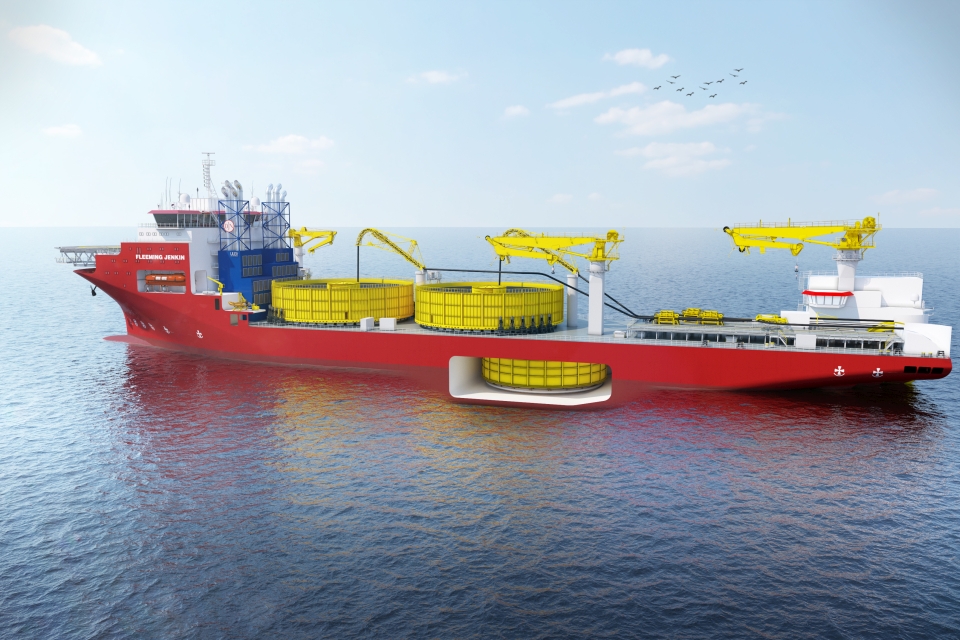Jan De Nul Group has ordered an extra-large cable-laying vessel, to be named Fleeming Jenkin, at the CMHI Haimen shipyard. With an unrivalled cable-carrying capacity of 28,000 tonnes, it will be the world’s largest cable-laying vessel to date.
The vessel will serve the renewable energy and subsea cable industry in installing cables over longer distances and in deeper waters. The vessel will be delivered in 2026.
Offshore wind farms go deeper and further offshore, and the interconnectivity between countries and regions will become essential for the economy and energy security. Both markets today require longer, stronger and heavier cables for deeper waters.
‘Following our previous investments in the jack-up vessel Voltaire and crane vessel Les Alizés for the installation of the next-gen wind turbines and their foundations, we now proceed with this magnificent cable-laying vessel,’ says Philippe Hutse, Director Offshore Energy Division at Jan De Nul Group. Thanks to her unprecedented capabilities, Fleeming Jenkin will be a perfect fit for the interconnector and export cable markets.’
Also read: Jan De Nul fixes Les Alizés and Voltaire on long-term charter to RWE
Offshore installation fleet
Jan De Nul’s offshore installation fleet will count four powerful and diverse cable-laying vessels, next to two offshore jack-up installation vessels, three floating crane installation vessels, five rock installation vessels and two multipurpose vessels.
Jan De Nul has already started recruiting extra crew and staff members to operate Fleeming Jenkin. Supported by an extensive in-house training programme, a multidisciplinary team of dynamic positioning officers, engineering technicians, tensioner carrousel operators, cable-laying superintendents, various specialised offshore technicians and engineers in civil and mechanical engineering will be put together.
Also read: Jan De Nul lands German cable system portfolio
Fleeming Jenkin capacities
The cable-carrying capacity of Fleeming Jenkin is a first for the offshore installation market. The vessel will be equipped with three cable carousels and a large hold for fibre optic cables, capable of laying up to four cables simultaneously. Two carousels are mounted on deck, with a third below deck. The combined cable-carrying capacity amounts to 28,000 tonnes, which is double the capacity of any other cable-laying vessel on the market.
The vessel is designed to install longer and heavier cables, into ultra-deep waters up to 3000 metres. On the aft deck, the vessel is equipped with a chute and a cable-laying wheel. In combination with the tensioners, the chute allows installation of cables in shallow waters, while the cable-laying wheel makes installation at great depths more efficient. The tensioners enable the vessel to handle and control cable tensions up to 150 tonnes.
The vessel is equipped with a powerful DP2 system, enabling it to operate steadily in deep, but also in shallow waters, thanks to an additional third bow thruster.
Wouter Vermeersch, Manager Offshore Cables at Jan De Nul: ‘Fleeming Jenkin bundles all the cable installation expertise we’ve gained over the past decade. This vessel and technologies on board are designed by our in-house specialists. In 2013, we changed the power cable installation market by introducing our cable-laying vessel Isaac Newton with higher carrying capacities than available on the market. Today, we continue our pioneering entrepreneurship by ordering the world’s most advanced cable-laying vessel.’
Also read: Jan De Nul and DEME unveil offshore floating solar tech
Ultra-Low Emission vessel
Green technologies on board turn Fleeming Jenkin in a sustainable and future-proof asset. The ship will be equipped with a highly advanced dual exhaust filter system, which removes up to 99 per cent of nanoparticles from emissions using a diesel particulate filter (DPF) and a selective catalytic reduction system (SCR) for NOx removal. The Ultra-Low Emission (ULEv) system also significantly reduces exhaust gas pollutants.
Thanks to the ULEv system, the vessel complies with European Stage V emission standards for inland waterway vessels. Moreover, the NOx emissions are reduced to such an extent that this vessel meets the even stricter EURO VI emission limits.
Biofuel and green methanol
The vessel is powered by engines that can run on biofuel and green methanol, confirmed by the methanol-fuel-dual-fuel notation, which significantly reduces CO2 emissions.
The hybrid power plant on board also contributes to the reduction of CO2 emissions and optimal fuel usage. It combines the generators with a 2.5 MWh battery and drive technology, designed for peak shaving, load smoothening, spinning reserve and optimised engine loading.
Also read: Jan De Nul’s Les Alizés headed for Europe
Henry Charles Fleeming Jenkin
The vessel is named after Henry Charles Fleeming Jenkin (1833-1885), born in England and a Regius Professor of Engineering at the University of Edinburgh. As an electrical and cable engineer, Jenkin was an active pioneer in offshore cable installation.
Picture: Fleeming Jenkin will have a cable-carrying capacity of 28,000 tonnes, twice the capacity of any other cable-laying vessel available on the market.








